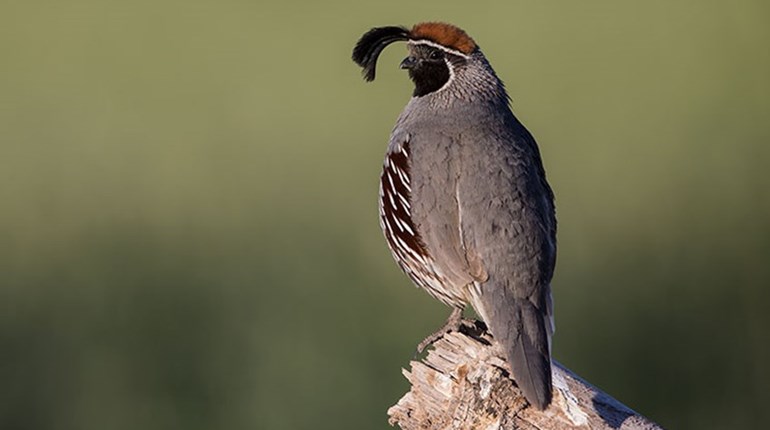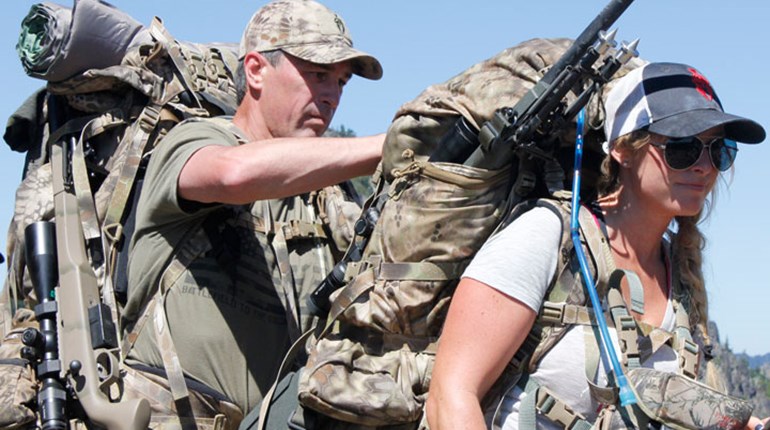By mid-September a plethora of hunting seasons are underway for feathered protein in our Northwest mountain states. It might be summer-hot in Missouri, but it could be snowing above 9,000 feet in the mountains of Montana. Why don’t you and your hot dog cool off with some of the earliest, hottest bird hunting in North America?
Action like this:
“Isn’t that your Brittany on point?” I yelled across the draw.
“Where?” Chris shouted back.
“Down at the edge of that string of aspens. More to the left.”
“Oh. Yeah, it is. Circle to the right and I’ll come in from this side.”
I trotted, my 28-gauge Ruger Red Label broken open, to close the 200-yard distance to the dog. Chris got there first, but stopped 40 yards shy, waiting for me to reach an equal distance. Then we closed in, guns loaded, hearts racing, hands sweaty in the September sunshine. There was no hurry, really. We were the only two hunters we’d seen all day, even though we were working an Idaho state public hunting area then open for at least six game bird species. We’d already bagged one of them, a brace of sage grouse my setter had pointed within slingshot distance of the trail where we’d parked the truck. The big birds had flushed in a ragged bunch, looking like C-130 transport planes trying to get airborne.
This next covey of birds arose more like jet fighters. Eight sharp-tailed grouse leapt from the grass at the edge of the shady aspen grove, loath to work so hard in the heat, but less eager to allow us a closer approach. My first shot rocked a bird. My second tumbled it. Chris knocked down two and the dogs went to searching. With two species in the bag, our day was already a success, but we were just warming up. Later, both dogs slammed on point on a grass flat, crested wheat grass bending in the breeze around their bellies.
“Might be a single from that bunch of sharptails,” Chris warned. Before I could respond, the grass erupted with a dozen or more gray partridge. If the sharptails had risen like jets, these little partridges exploded like missiles, but so tightly packed that I dropped two with a single shot. I was bearing down on a whirring third bird when I heard Chris’ second shot …
Before we settled in for a campfire dinner of sautéed bird breasts that evening, we’d added blue grouse and mourning doves to the menu.
To many Eastern bird hunters, five species in one day might sound fantastic enough to be a lie, but in the American West it’s ho hum ordinary. Had Chris and I chosen our hunting grounds a bit more carefully, we could have added ruffed grouse, spruce grouse and perhaps chukars to our bag.
Terrain Makes Variety
Western mountains create a refreshing diversity of micro-climates and habitats from rain forests to deserts, and upland birds evolved to take advantage of them. While the Southeast makes do with bobwhite quail, the West grows those plus California quail, mountain quail, Gambel’s, scaled and Mearn’s or Montezuma quail. That’s six species, just of quail.
If you prefer birds with more meat on their bones, we have you covered. Climb into the mountain coniferous forests and you’ll bump 3-pound blue grouse, now known as dusky or sooty grouse, depending on where you find them. Stroll along the deciduous brush bordering streams and you’ll spook bunches of ruffed grouse, the same red- and gray-phase birds found in the Northeast and Great Lakes states. Continue climbing until you’re near the alpine zone and the rarely encountered spruce grouse pops up. Not the most sporting bird to shoot, but challenging to find and flush and surprisingly tasty.If you prefer open grasslands and sage-steppe habitats, go ahead and hike them if you like. Chances are you’ll discover gray partridge lurking about the edges of wheat fields. Chukar partridge will be calling from canyon country, badlands and steep, rocky terrain. Sharptail grouse fan across a variety of grass and brushlands, and sage grouse cling to life in remnants of good sagebrush steppe, habitat so long abused that sage grouse may soon be off the hunter’s menu due to low numbers. On the eastern fringe of the Great Plains states from Oklahoma to North Dakota you’ll even find good numbers of greater prairie chickens, the same species that used to live in Ohio, Missouri and Illinois, where corn and soybeans have driven them out.
Let’s see, that’s 14 upland species. Still not satisfied? Okay, lace tight your mountain boots and suck up some extra oxygen so you can hike into the high tundra to chase white-tailed ptarmigan, the whitest bird in the world and a true trophy for any hunter. Just as high and even tougher to bag is the rare, introduced Himalayan snow-cock in Nevada. You need a special tag to pursue this one—and plenty of determination. Can you handle 13,000 to 14,000 feet elevation?
Still not convinced the West is the place for upland hunters? Aim your rig north toward Alaska and you can pick up willow ptarmigan and rock ptarmigan, the final two species on our Hit Parade of Western Upland Birds.
Wait a minute. What about the most durable, most colorful and most popular upland bird of all, the ring-necked pheasant? Sure. It’s here too, but seasons for this naturalized exotic generally don’t open until mid-October or later, and this article is all about hitting the action early, before the crowds descend on your home-ground birds. Perhaps you can dampen your pheasant lust by adding mourning doves, white-winged doves or band-tailed pigeons to your list. They aren’t upland birds, but seasons for them are concurrent with many upland seasons. You need to check regulations and season dates state by state. The farther south you go, the later many open. But, regardless whether the action starts in August or not until November, the West is absolutely a bird-hunting cornucopia spilling over with opportunities.
You Own Land!
I don’t think 19th-century authors had upland birds in mind when they advised young men to go west, but I do. Anyone with young lungs and legs and a burning desire to use them in pursuit of our hunting heritage owes it to himself—or herself—to sample the West because you own land out here! Much of the best Western bird habitat is public land wide open to hunting. There are millions of acres just waiting for you: Forest Service lands, Bureau of Land Management lands, Bureau of Reclamation lands, Army Corps of Engineer lands and state wildlife management lands. All you need is an appropriate state hunting license, a land-ownership map or GPS and enthusiasm.
Not only can you hunt freely on these lands, but you can camp on most of them, too. It’s “primitive camping,” meaning you pull up to a patch of ground and make camp without the modern “campground” luxuries of toilets, potable water or even tent pads. It’s camping as wild as when Clovis hunters pursued mammoths. Unlike them, however, you’ll be able to drive your camper, pull trailer or truck to your campsite and set it up as elaborately as you want. For efficiency, my favorite rig is a camper atop a four-wheel-drive truck. That way I can follow my nose and camp wherever I find birds. No late-night drives back to a tent or cabin, and no wet tent to disassemble each frosty morning. Campfires are usually permitted unless wildfire conditions are extreme. Check with land management agencies for current restrictions.
Doggone Delightful
Western bird hunting is for the dogs. You can come, too, but by all means bring the dogs. World-class pointers, backyard retrievers, leaping flushers—it doesn’t matter. With all these acres and all this cover, the West’s upland habitat is tailored for the joy of hunting dogs. They’ve got more room to run than they’ll ever see east of the Mississippi and more birds to sniff than they can nose up in a lifetime anywhere else.
Warning: Get them in shape. Be prepared for danger like cliffs, cactus spines, porcupines, wolves and rattlesnakes. I won’t sugar-coat this. Conditions can be tough out here. Rocky ground alone can wear off soft pads in a day. Get Pooch in his best shape ever and prepare for harsh conditions. Consider a chest protector, booties, snake-bite aversion training and an extensive first-aid kit. Google names and numbers of emergency vets in areas you plan to hunt. Along with wolves, you could run into bears and mountain lions. Wolves will kill a strange dog in an instant, so if you hunt wolf country, keep a bell or electronic collar on Pooch at all times. Keep her close and be ready to run to the rescue. Now that wolves are again being hunted, they’re less bold than they were from 1996 to 2010, but they’re still a threat. Bears and cougars usually stay out of your way.
To be fair, run at least two dogs, alternating. They can wear out in a day or two. Carry quick-energy food and plenty of water to get them out of rough country. Don’t freak out about these challenges. We Westerners run dogs of all types all the time. My setters, Labs, Pudelpointers and springers have been scouring the West from Canada to Mexico since 1971 and I haven’t lost one yet. A moose once chased my setter to my feet, but that’s another story.
Research First
Not every successful Western bird hunt begins with research—just most of them. You need to get online and discover which states hold seasons for which species and when. Then dig deeper to determine where within those states you can find various species. Sometimes they’re isolated, sometimes widely disbursed and sometimes they’re nicely mixed in one spot. After you’ve identified a few potential hot spots, start calling local game wardens and biologists for confirmation. Ask how local bird populations are faring. Have floods, drought, fires or suburban development negatively altered their living spaces? Are populations low, medium or high? What’s the hunting pressure like? Sometimes you’re better off hunting a less popular area with lower bird densities but also low hunter densities.
Don’t settle for one hot spot. Identify several so you can move quickly and efficiently should your first pick prove less than productive. The West is big. You can waste a day crossing just one state. Line up your spots and plan your routes carefully.Some hunts can begin right out your truck door, but a few require lengthy hikes to reach productive ground. White-tailed ptarmigan, for example, live at the highest elevations that you can reach only after long, lung-busting climbs—unless you carefully research highways and Forest Service roads that reach above treeline. Those will save you hours of work. In the far north you may need an air taxi to reach good ptarmigan habitat. Research, research and plan, plan, plan.

Young, Dumb, Abundant & Thirsty
September is prime time because annual bird numbers are at their peak, young birds are inexperienced (read: easy to approach) and even adults hold well for pointing dogs. Birds are often thirsty and hanging near sources of standing water such as springs, cattle ponds, windmills and man-made tanks. Irrigated crop fields also attract them, concentrating coveys in small, well defined areas. Chukars, blue grouse, ruffed grouse and some quail can even be hunted by boating or floating rivers and lake shorelines. Float and fish until you hear or spot birds near the water. Then land the boat, load the guns, loose the dogs and have at ’em. If it gets too hot, retire to the water and jump in. Delightful. And at dinner time … well, birds will never be more tender.





































